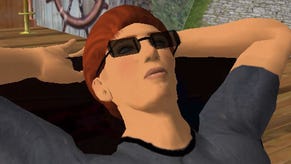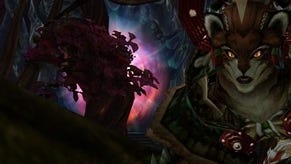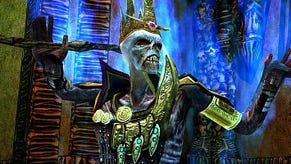Second Life at ten: a decade of expression - part two
Second Life just turned ten. VG247's Dave Cook continues his discussion with some long-time residents about what happens when residents die in real-life, and the the divide between a person's Second Life and reality.
If you missed part one of this article, where we discuss the involvement of developer Linden Lab, acceptance, gender orientation and more, you can play catch-up here.
Despite the initial waves of articles I read years ago decrying Second Life as some kind of ghoulish digital world that tricked your children into confusing the virtual and real, I was yet to encounter anyone that fit that description across my travels.
Not that I ever believed the stereotype for a second of course.
No matter what your view of Second Life, it's important to remember that there are still people behind the avatars that inhabit Linden Lab's world.
Most of the residents I spoke with were happy to discuss their in-world habits, but were reluctant to divulge their real name or offer much insight into what they did away from their computer.
It goes to show that while it's perfectly natural to become immersed in digital landscapes – remembering that we gamers do it regularly as well – that there is still a clear separation from Second Life and reality. In fact residents regularly refer to the world and real life as 'SL and 'RL' respectively.
I spoke with Perrie, a Second Life resident for over six years about why they had taken up residency in-world, and their reply underlined this distinction perfectly.
Separating Second Life from reality
“I was in a RL relationship that broke up," Perrie told me. "I was looking for a mental diversion and had read an article or blog once about SL. I remembered it and decided to check it out. As I started to explore SL and meet other people”.
While some onlookers might call in-world inhabitants 'Avatars', Perrie has always viewed them as people in the first instance, and added, “I also started learning more about myself as I interacted with others and found great happiness in the ways that I was able to express myself. It is perhaps these interactions and the way I live my SL that are probably the biggest reasons that I have stayed so long.”
I asked for some insight into Perrie's personal distinction between their real life and Second Life, and was told, “I'm not sure what you are asking here. I do have RL contact with a few SL friends but generally speaking a lot of my RL - especially my real identity - I consider no one else's business. Beyond that I don't really make a distinction. They are both part of my whole life. I am very involved in both RL and SL activities.”
Intrigued by Perrie's response, I asked Dillon the same question and received a very different answer, “I have a plaque on the wall of one of my buildings that reads, 'The only things real in Second Life are our feelings'. I didn't write that but it seems accurate to me. My SL avatar is me. Talks like me, thinks like me, reacts like me, loves like me.
“I don’t use the term ‘real life’ at all. Your ‘real life’ is what you do with your time, whether that is work, time with your family, hobbies, or online gaming. I don’t have a ‘Second Life’, I use Second Life.”
“My avatar Doesn't play roles except of course for the obvious role: I'm a male attempting to look female. The big difference between RL and SL is that in RL I don't dress female at all these days, and the period in which I did was both brief and carefully controlled. In SL I'm dressed female all the time.”
Tateru added, “What seems to be the vast majority of Second Life users - there are exceptions – is that I’m the same person when I’m using Second Life than when I’m not. Whatever my avatar might look like from month to month or day to day, I’m the same person, behaving as I would in any other place and time
“I don’t use the term 'real life' at all. Your 'real life' is what you do with your time, whether that is work, time with your family, hobbies, or online gaming. I don’t have a 'Second Life', I use Second Life.”
Once again I was speaking with three very different people each with their own reasons for living within Second Life, and while they all felt that Linden's world was an integral, natural part of their lives, the two have never bled together in an unhealthy manner.
It's impossible to say that nobody has ever become addicted to Second Life however, because people can become overly-absorbed in anything given the chance, but I never once felt that my three interviewees had crossed a line.
I remember when I was younger hearing about Second Life when it launched and actually feeling quite worried by the prospect of a virtual world that mirrored our own so acutely, as if it was something to fear. But like all new prospects it starts to make sense as your understanding grows.
It operates in a similar manner as CCP Games' space-faring MMO Eve Online, which delivers a world with few rules, a working economy and the freedom to create a deep persona. It's a realm that can become permanently altered by the actions of a few, where individual feats of bravery or malice can go down in legend.
Second Life isn't a game, but the freedom of expression afforded to residents is equally – if not more – profound than its forebears.
Harsh Reality
While many Second Life residents enter Linden Lab's world to escape reality for a while, it is entirely possible for events happening in real life to emerge within and deliver an unexpected sucker punch. It's key to understand that these avatars are controlled by real people who have a daily routine, careers and in some cases, hardships they have to face each day.
These people live away from the virtual landscape when they're not logged in, and just like all of us, they die. Seeing as Second Life has been around for a decade, many residents have suffered the death of their digital neighbours, friends and colleagues in the past. Real or not, the passing of an avatar's keeper is never an easy thing to witness.
“One of my close Second Life friends had died of acute respiratory failure,” Tateru told me. “A couple of weeks later, I saw her account come online. It was a very disturbing moment. It was her son, in fact, whom I had met previously. Her will had allowed Linden Lab to pass the account to her son to wind up her affairs. In a way it was almost heartbreaking seeing her account online again for those couple of days”.
Tateru added that shortly after the son went in-world to tie up his mother's avatar, a group of residents decided to craft a memorial park and name it in her honour. There really is a state of kinship at play throughout Second Life, and despite the owners of many avatars never meeting in real life, the fact is largely irrelevant. These people connect just as you might with your best friend in a bar, or over dinner.
To many residents, meeting at a real social event or taking your avatars for a stroll while chatting are considered one and the same. When that relationship ends it can prove just as heart-breaking as any other dispute or falling out, so it's disheartening to hear just how earth-shattering a death in these virtual families can be.
“I’ve built a few things, mostly houses for me. I’ve never tried or even considered creating something for the purpose of selling it. If I ever have enough in-world time to work on learning how to do more things, that might change.”
Another harsh reality of Second Life is that while the ability to make real money does exist if you're proficient at coding virtual goods, there's absolutely no guarantee of making a fast-buck.
There was something of a gold rush back in the mid-noughties that saw residents creating virtual content by the truckload in the hope of striking it rich overnight.
I remember reading about Anshe Chung, a virtual land baron who started her Second Life with an investment of just $9.95 and by 2006 had earned real-world profits of over $1 million.
Real name Ailin Graef, she became a bona fide celebrity in the tech arena, and her success attracted many newcomers to Linden's seemingly accessible gold mine.
The reality is that it's actually very difficult to make money in Second Life unless you identify a gap in the market, and turning profit demands that you have the coding skills to make wares worth buying. Each of my interviewees had dabbled in content creation in the past, so I asked them for insight into their own experience.
“I do. Many of us do,” Tateru replied. ,”if only for ourselves and our friends. As for making an income with it, that is no harder - and no easier - than creating a flow of income from any other business, online or off.
“You identify what people are willing to pay for, and for how much, you make your investments, you work hard and spend money on marketing – and you stand about the same chances of success or failure of any startup business.”
Dillon added, “Yes. I've built a few things, mostly houses for me. I've never tried or even considered creating something for the purpose of selling it. If I ever have enough in-world time to work on learning how to do more things, that might change.”
After weeks of speaking with each resident and experiencing Second Life for myself, I quickly gained a new-found respect for anyone who had successfully turned a profit in-world. It appears to be an uncompromising place to begin with, but the more I conversed with people all of these layers of doubt and confusion started to peel off one by one.
For all the collective years Tateru, Dillon and Perrie had spent as residents in Linden's virtual space, people do leave Second Life for good, sometimes after committing to their avatar's existence solidly over a long span of time. To close my investigation into this intriguing world and its inhabitants, I asked a difficult question: “What pushes people away?”
Ending your Second Life
Perrie offered many possible reasons a person might want to call time on their Second Life saga, such as real-life commitments getting in the way, and explained that some people simply come away with a negative experience. “Second Life can involve a lot of mental focus." Perrie explained, “and it is easy to get deeply involved emotionally. People can get very involved emotionally with another Avatar and when the relationship breaks up it has a very real impact on them.”
Tateru then explained that some people leave because Second Life has been sold incorrectly to them as a game, or as a way to make quick money, while others find it hard to break through that initial barrier of information and direction-less meandering. It's hard to know exactly what you're supposed to do in-world when the choice is entirely yours.
This sheer scope is largely the reason I took the advice of my sources and abandoned my target of summarising Second Life in its entirety. There's was too much to say in such a short span of time, and too many complex issues to fit into one article, but I had hoped to at least cover the basics and maybe get some newcomers intrigued enough to give the world a try.
“Second Life can involve a lot of mental focus, and it is easy to get deeply involved emotionally. People can get very involved emotionally with another Avatar and when the relationship breaks up it has a very real impact on them.”
The pitch was also a way of furthering my own understanding, and to get a handle on why Second Life had endured for the past decade, while hearing all about it from people who had lived and breathed it for years before. I came away admiring their dedication, passion and openness when talking about their virtual others.
It's hard to say when the lives of these residents will come to an end, or morbidly – whose life will end first, theirs or that of the avatar – but either way one existence seems to compliment each other on a profound level. Relationships forged in-world may make residents happier in reality, while positive events within Linden's world may turn a person's actual day around.
To say that this relationship between the real and virtual is symbiotic may stray too far towards sensationalism and the idea that dedicated Second Life residents are obsessed. In my experience I found that in all cases there is an invisible line drawn between Linden's world and our own that is constantly noted and respected.
In the end, if escaping away to this whimsical, often joyous plane of existence can help a person get more enjoyment out of life then who are we to argue with a resident's rationale?
If you asked me this question back in 2003 when Second Life began then I'd probably look at the world with equal parts scepticism and wonder, but now I understand the key appeal; which is the prospect of near-infinite expression, something few of us are afforded in these increasingly hectic times.
Are you a Second Life resident? If so, share your memories of your time in-world with us below.













